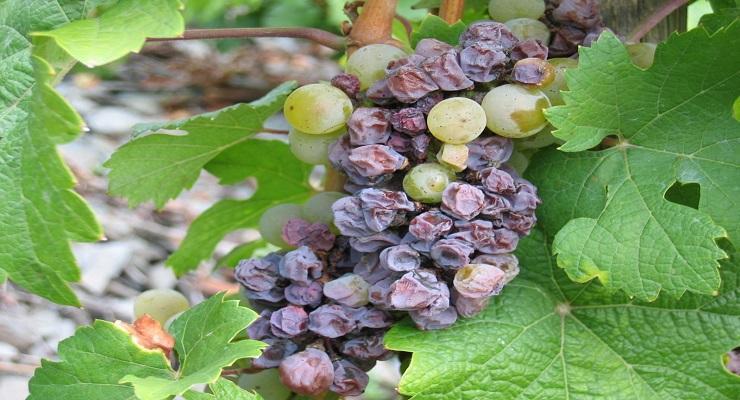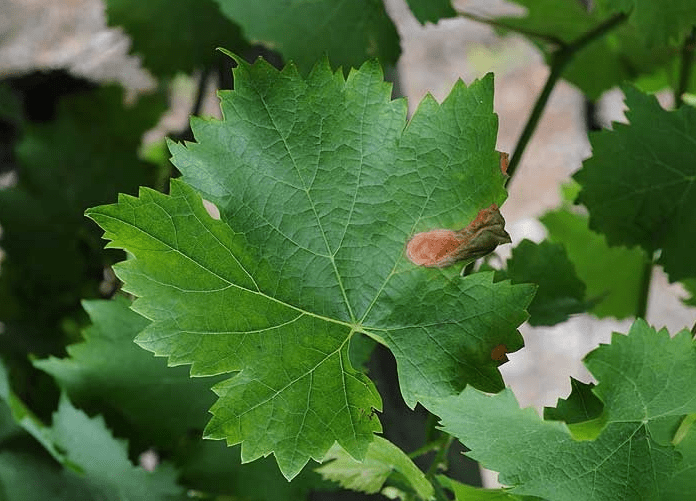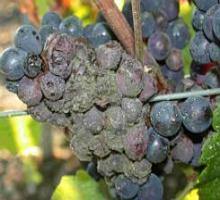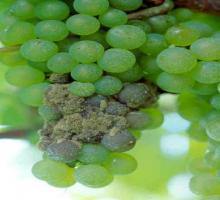Grey mold of grapes (Botryotinia fuckeliana) – identify and control

Grey mold of grapes occurs in all countries where vines are grown, destroying a large part of the harvest in autumn, especially in years with abundant rainfall. Significant damage also occurs on grafted stumps.
Symptoms. Grey mold of grapes occurs less on leaves, leaf litter, and young bunches, but very frequently on mature berries close to harvest. Yellowish spots appear on the leaves at first, then turn reddish. On both sides of the leaf, a greyish, powdery down develops on the right side, made up of the fruiting bodies of the fungus.
Heavily attacked leaves twist, break off and fall off the leaves. The disease only develops on leaf litter under high humidity conditions. The infection starts at the nodes, where whitish or light yellowish spots appear, which elongate along the internodes.
Attacked tissues are covered with a greyish down, similar to that on leaves. Sometimes small, ovoid, black corpuscles are formed in this down, which are the sclerotia of the fungus.
Grafted seedlings placed in wet sand are attacked at the grafting point, where fungal sclerotia develop, which prevents the graft from being welded to the rootstock.
The most damaging attack is on the berries during ripening.



At first, small spots are visible on their surface, that quickly grow and penetrate into the pulp of the berry.
The patches are yellowish-grey or reddish-purple. Infected berries soften, crack and become covered with a dusty, greyish-brown, powdery down. It spreads from berry to berry, covering the entire cluster, especially in varieties with dense berries. The disease is favored by insect bites, hail damage, and the cracking of fruits epidermis in the vine, a common phenomenon during autumn rains.
The attacked grapes produce weak wines, with low alcohol content and are not suitable for aging and bottling.
In certain areas, on certain soils, on certain varieties, the fungus also produces the so-called “noble rot”. This increases the sugar concentration of the fruit because the fungus mycelium consumes a quantity of water from the berries.
The attacked fruits have a vine color, they are mummified. On their surface, the fungus spores no longer form. The juice obtained has a particularly pleasant aroma, and the high sugar concentration results in liqueur-like, strong wines of outstanding quality.
This “noble rot”, desired by winegrowers, reduces grape production by more than 40%.
The attack of the fungus is favored by high humidity (over 80%) during the ripening period of the grapes and temperatures between 25-28º C. Intense attacks occur after heavy rains accompanied by hail.
On the attacked organs the fungus forms black, rigid, irregularly shaped microsclerotia. The pathogen is transmitted from one year to the next by sclerotia, the resistance mycelium on the attacked cords, and by conidia, which can survive at low temperatures. The pathogen actively penetrates through the epidermis or passively through the wounds of the plant.
Prophylaxis. Cultivation of resistant vine varieties, control of insects that cause fruit injury, early harvesting of vines in rainy and warm autumns are recommended. Fungicide treatments should be made immediately after the falling of petals, when the clusters take on the characteristic shape of the variety, at the entry of the vine and 3 weeks before harvest.
Recommended products
-
You can find products on a different store
Change Store -
You can find products on a different store
Change Store -
You can find products on a different store
Change Store -
You can find products on a different store
Change Store -
You can find products on a different store
Change Store -
You can find products on a different store
Change Store -
You can find products on a different store
Change Store -
You can find products on a different store
Change Store -
You can find products on a different store
Change Store -
You can find products on a different store
Change Store -
You can find products on a different store
Change Store -
You can find products on a different store
Change Store -
You can find products on a different store
Change Store -
You can find products on a different store
Change Store -
You can find products on a different store
Change Store -
You can find products on a different store
Change Store -
You can find products on a different store
Change Store -
You can find products on a different store
Change Store -
You can find products on a different store
Change Store -
You can find products on a different store
Change Store -
You can find products on a different store
Change Store -
You can find products on a different store
Change Store -
You can find products on a different store
Change Store -
You can find products on a different store
Change Store















































































































































































































































































































































































































































